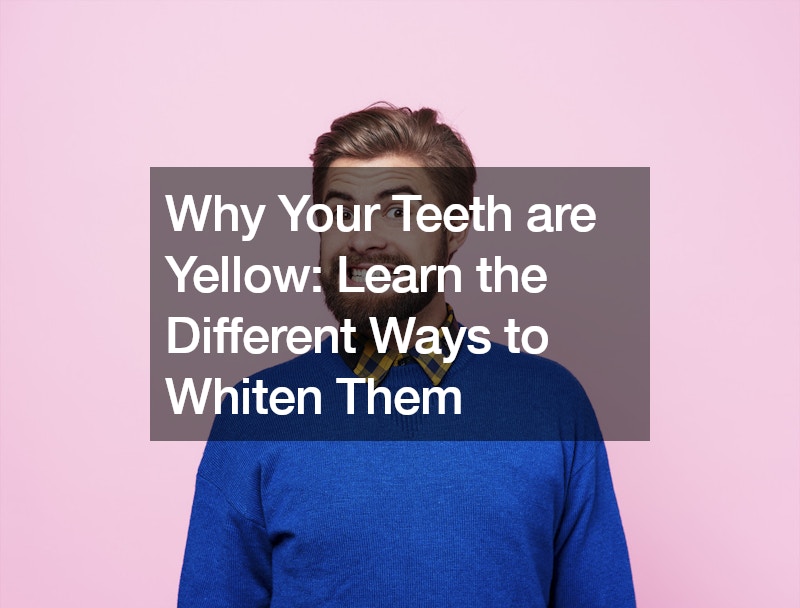
Have you ever wondered why your teeth aren’t as white as you’d like them to be? Yellow teeth can be a source of embarrassment for many people, but understanding the reasons behind this discoloration is the first step toward achieving a brighter smile. In this article, we’ll explore why teeth turn yellow and discuss various methods for whitening them.
Understanding Yellow Teeth
Yellow teeth can result from a variety of factors, both intrinsic and extrinsic. The intrinsic stains occur within the inner structure of the tooth, often due to trauma or developmental issues. On the other hand, extrinsic stains affect the outer surface of the tooth and are typically caused by factors such as diet and lifestyle habits.
Causes of Yellow Teeth
Extrinsic stains are the most common cause of yellow teeth. These stains occur when pigmented particles from food and beverages, such as coffee, tea, and wine, adhere to the enamel—the outer layer of the tooth. Over time, if these particles are not removed through proper oral hygiene practices, they can penetrate the enamel and contribute to discoloration.
Intrinsic stains, although less common, can also lead to yellow teeth. These stains occur within the dentin—the inner layer of the tooth—and are often the result of factors such as trauma, certain medications (like tetracycline antibiotics), or developmental conditions.
Genetic Factors in Tooth Color
Genetics play a role in determining tooth color and susceptibility to staining. Some individuals may inherit naturally whiter teeth, while others may be predisposed to yellowing due to genetic factors.
Age-Related Changes in Tooth Color
As people age, their teeth tend to become more yellow. This is because enamel wears down over time, exposing more of the yellowish dentin underneath.
Prevention and Maintenance
Preventing yellow teeth starts with practicing good oral hygiene. Brushing your teeth at least twice a day, flossing regularly, and visiting your dentist for routine cleanings can help remove surface stains and prevent the buildup of plaque and tartar. Additionally, avoiding foods and beverages that are known to stain teeth can help maintain a brighter smile.
Common Foods and Beverages that Cause Tooth Discoloration
Common foods and beverages can significantly contribute to tooth discoloration, affecting the brightness of your smile over time. Among the primary culprits are coffee, tea, red wine, and berries.
Coffee, a morning staple for many, contains dark pigments that can adhere to the enamel of your teeth, leading to stains. Similarly, tea, especially black tea, contains tannins that promote staining. Red wine, with its rich color and acidic nature, can also leave behind stains on tooth surfaces.
Berries, despite their health benefits, can contribute to tooth discoloration due to their vibrant pigments. Blueberries, raspberries, and blackberries contain chromogens, which are highly pigmented compounds that easily bind to tooth enamel.
These staining foods and beverages can gradually discolor teeth, especially when consumed regularly over time. While enjoying these items in moderation is acceptable, practicing good oral hygiene habits such as brushing and rinsing with water after consumption can help minimize their staining effects. Additionally, scheduling regular dental cleanings with your dentist can remove surface stains and keep your smile looking bright and healthy.
Whitening Solutions
If your teeth are already yellow and you’re looking for ways to whiten them, there are several options available. Using over-the-counter whitening products such as whitening strips or toothpaste can help remove surface stains and lighten the color of your teeth over time.
For more significant whitening results, professional whitening treatments administered by a dentist are recommended. These treatments often involve the use of bleaching agents that are more potent than those found in over-the-counter products, resulting in faster and more noticeable results.
Professional Dental Cleanings and Their Role in Whitening
Regular dental cleanings are essential for maintaining white teeth. Dentists can remove surface stains and tartar buildup during cleanings, helping to restore the natural brightness of the smile.
Tips for Maintaining a White Smile
Maintaining good oral hygiene habits, avoiding staining foods and beverages, and quitting tobacco use can help prevent yellowing teeth. Additionally, using whitening toothpaste or undergoing professional whitening treatments can help keep the smile bright and white.
Conclusion
Yellow teeth can be a source of insecurity for many people, but understanding the causes of tooth discoloration and the available whitening solutions can help you achieve the bright smile you desire. By practicing good oral hygiene, avoiding staining foods and beverages, and exploring whitening options with your dentist, you can take proactive steps toward maintaining a healthy, white smile.
Remember, if you have concerns about the color of your teeth or are considering whitening treatments, it’s essential to consult with a dentist to determine the best course of action for your specific needs. With the right approach, you can enjoy a confident, radiant smile for years to come.
.

